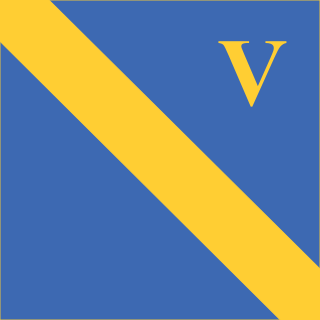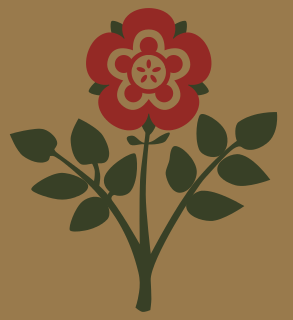
The 53rd (Welsh) Infantry Division was an infantry division of the British Army that fought in both the First and Second World Wars. Originally raised in 1908 as the Welsh Division, part of the Territorial Force (TF), the division saw service in First World War, being designated 53rd (Welsh) Division in mid-1915, and fought in the Gallipoli Campaign and in the Middle East. Remaining active in the Territorial Army (TA) during the interwar period as a peacetime formation, the division again saw action in Second World War, fighting in North-western Europe from June 1944 until May 1945.

The 5th Infantry Division was a regular army infantry division of the British Army. It was established by Arthur Wellesley, 1st Duke of Wellington for service in the Peninsular War, as part of the Anglo-Portuguese Army, and was active for most of the period since, including the First World War and the Second World War and was disbanded soon after. The division was reformed in 1995 as an administrative division covering Wales and the English regions of West Midlands, East Midlands and East. Its headquarters were in Shrewsbury. It was disbanded on 1 April 2012.

The Devon and Cornwall County Division was a County Division of the British Army created during the Second World War. It was formed on 28 February 1941, from recently recruited soldiers, in response to the renewed threat of a German invasion. The 10,000-strong division was a static formation, lacking transport, intended to defend possible landing sites along the southern Cornish and Devon coastlines from invading German troops. The creation of the division also helped to free up the more experienced troops, who were then held back from the coastline to be able to launch a counterattack against any potential German landings.

The Dorset County Division was formed on 24 February 1941. However it did not take over operational commitments from Southern Area until March 10 and it did not finally assume command of its allocated infantry brigades until 24 April. It only had a short existence, being reduced to an administrative headquarters on 24 November at midday. The whole headquarters was disbanded on 31 December.

The Essex County Division was a formation of the British Army formed in the Second World War on 18 February 1941 by the redesignation of the West Sussex County Division. It lasted until 7 October when it was disbanded. It had one commanding officer, Major-General J. H. T. Priestman, It was under the command of XI Corps from formation to 22 July and then under GHQ Home Forces.
The West Sussex County Division was a formation of the British Army, raised in the Second World War and formed by the redesignation of Brocforce on 9 November 1940. It was redesignated on 18 February 1941, becoming the Essex County Division. It was commanded by four officers, Major-General Edwin Morris from formation until 16 December, Brigadier A. E. Lawrence until 29 December, Major-General Sir Oliver Leese until 30 January 1941 and then Brigadier H. J. Parham. It commanded 29th Infantry Brigade and 201st Independent Infantry Brigade (Home). It was commanded by XII Corps until 15 January 1941 and then by IV Corps.

The 55th Infantry Division was an infantry division of the British Army's Territorial Army (TA) that was formed in 1920 and existed through the Second World War, although it did not see combat. The division had originally been raised in 1908 as the West Lancashire Division, part of the British Army's Territorial Force (TF). It fought in the First World War, as the 55th Division, and demobilised following the fighting. In 1920, the 55th Division started to reform. It was stationed in the county of Lancashire throughout the 1920s and 1930s, and was under-funded and under-staffed. In the late 1930s, the division was reduced from three to two infantry brigades and gave up some artillery and other support units to become a motorised formation, the 55th Motor Division. This was part of a British Army doctrine change that was intended to increase battlefield mobility.

VII Corps was an army corps of the British Army active in the First and Second World Wars. In the early part of the Second World War it was part of the defence forces of the United Kingdom, and later acted as a shadow formation for deception purposes.

The Home Counties Division was an infantry division of the Territorial Force, part of the British Army, that was raised in 1908. As the name suggests, the division recruited in the Home Counties, particularly Kent, Middlesex, Surrey and Sussex.
The 76th Infantry Division was an infantry division of the British Army, which was formed in November 1941 and served during the Second World War. It was created when the Norfolk County Division, initially raised in 1940 to defend the Norfolk coast from a potential German invasion, was redesignated. The division maintained the defensive duties that had been assigned to it, prior to it being renamed, until late 1942 when it became a training formation. It was then responsible for providing final tactical and field training to soldiers who had already passed their initial training. After five additional weeks of training, the soldiers were posted to fighting formations overseas. The formation was used as a source of reinforcements for the 21st Army Group, that was fighting in the Normandy campaign. After all available British troops had left the United Kingdom for France, the division was disbanded in September 1944.
The 133rd Infantry Brigade was an infantry brigade of the British Army that saw service during the First World War in British India, but never as a complete formation. In the Second World War, the brigade fought in the Battle of France in May 1940 and was evacuated at Dunkirk. It later fought in the North African Campaign, and was disbanded on 1 January 1943.
The 45th Infantry Division was an infantry division of the British Army, formed just prior to the start of the Second World War. In March 1939, after the re-emergence of Germany as a significant military power and its occupation of Czechoslovakia, the British Army increased the number of divisions in the Territorial Army (TA) by duplicating existing units. The 45th started forming in August 1939 and became active the following month, as a second-line duplicate of the 43rd (Wessex) Infantry Division. The division's battalions were all raised in the West Country.
The 47th (London) Infantry Division was an infantry division of the British Army that was formed during the Second World War and remained in the United Kingdom until the end of the war. In March 1939, after the re-emergence of Germany as a significant military power and its occupation of Czechoslovakia, the British Army increased the number of divisions in the Territorial Army (TA) by duplicating existing units. The 2nd London Division was formed in August 1939 as a second-line duplicate of the 1st London Division; its battalions were all initially London-based.
The 77th Infantry Division of the British Army was formed in 1941, during the Second World War, from the re-organisation of the Devon and Cornwall County Division. During its existence the division changed roles several times. The division's initial role was coastal defence, protecting Devon. On 20 December 1942, it was converted into a training formation, known as a reserve division. In this capacity, the division provided final tactical and field training for the infantry that had already passed their initial training. After five additional weeks of training, the soldiers would be posted to fighting formations overseas. The division also had a tank brigade attached to provide training in armoured warfare.

The 210th Independent Infantry Brigade (Home) was an infantry brigade formation of the British Army organised during the Second World War to command a group of newly raised Home Defence battalions. It was later converted to a frontline brigade that served with distinction in the later years of the war, the 38th (Irish) Infantry Brigade.

The 219th Brigade was a Home Service formation of the British Army during the First and the Second World Wars.

The 12th (Eastern) Infantry Division was an infantry division of the British Army, which fought briefly in the Battle of France during the Second World War. In March 1939, after the re-emergence of Germany as a European power and its occupation of Czechoslovakia, the British Army increased the number of divisions within the Territorial Army by duplicating existing units. The 12th (Eastern) Infantry Division was formed in October 1939, as a second-line duplicate of the 44th Infantry Division.
The 208th Independent Infantry Brigade (Home) was a short-lived Home Defence formation of the British Army during the Second World War.

The 6th Anti-Aircraft Division was an air defence formation created within Anti-Aircraft Command of Britain's Territorial Army just before the Second World War. It defended the Thames Estuary and the approaches to London during the Battle of Britain and the Blitz.

The 103rd Light Anti-Aircraft Regiment, Royal Artillery, was an air defence unit of the British Army during World War II. Initially raised as an infantry battalion of the East Lancashire Regiment in 1940, it transferred to the Royal Artillery in 1941. It served in Northern England and Northern Ireland but saw no active service. Shortly before D Day, it was broken up to reinforce other units that fought in the campaign in North West Europe.












